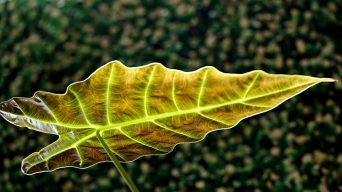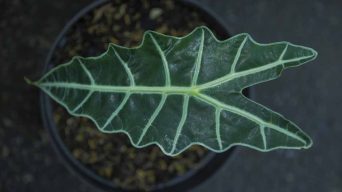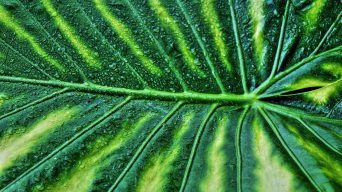Alocasia plants are typically known for their large, dark green leaves that add a tropical touch to any home.
They are easy to care for, making them a popular choice for indoor and outdoor gardens.
However, alocasia plants can sometimes experience leaf curling. This can be due to several reasons, ranging from pests to improper watering.
Here are 10 solutions to help you solve the mystery of why your alocasia leaves are curling.
Why Are My Alocasia Leaves Curling and How Can You Fix It?
There are several reasons why alocasia leaves may curl.
Here are the most common causes why alocasia leaves curl and how you can fix it:
1. Underwatering
One of the most common reasons for alocasia leaf curling is underwatering.
Alocasias are native to tropical regions and prefer moist soil.
When the plant doesn’t receive enough water, the alocasia leaves will begin to droop and curl in an attempt to conserve moisture.
How To Tell If Your Alocasia Is Underwatered
There are a few telltale signs that your alocasia plant is not getting enough water, including:
- Leaves that are wilted or drooping
- Leaves that are dry or brown at the edges
- Soil that is dry to the touch
- Stunted growth
How To Fix An Underwatered Alocasia
If you think your alocasia is underwatered, there are a few things you can do to fix the problem.
- Water your alocasia thoroughly, making sure that the soil is evenly moistened.
- Water more frequently, making sure to keep the soil moist but not soggy.
- Increase humidity by misting the leaves or using a humidifier.
- Remove any dried leaves or dead stems.
- Ensure that your alocasia has good drainage by using a well-draining potting mix and a pot with drainage holes.
2. Overwatering
While underwatering is a common cause of alocasia leaf curling, overwatering can also be to blame.
Alocasias are sensitive to overwatering and will start to experience leaf curling if they are sitting in water for too long.
How To Tell If Your Alocasia Is Overwatered
There are a few telltale signs that your alocasia is getting too much water, including:
- Leaves that are yellow or brown
- Leaves that are wilted or drooping
- Mushy or soft leaves
- Soil that is soggy or waterlogged
- Root rot
- Stunted growth
How To Fix An Overwatered Alocasia
If you think your alocasia is overwatered, there are a few things you can do to fix the problem.
- Stop watering your alocasia until the soil has had a chance to dry out completely.
- If the roots are rotting, you may need to repot your alocasia in fresh, dry soil.
- Make sure your alocasia is not sitting in water by placing it in a well-draining pot with drainage holes.
- If the leaves are wilted or yellow, you can try trimming them off to encourage new growth.
3. Pest infestation
Alocasias are also susceptible to pests, such as mealybugs, scale, and aphids.
These pests can cause alocasia leaves to curl by sucking the sap out of the leaves. This causes the alocasia leaves to turn yellow or brown and eventually drop off.
How To Tell If Your Alocasia Has A Pest Infestation
There are a few telltale signs that your alocasia plant has a pest infestation, including:
- Leaves that are yellow or brown
- Leaves that are wilted or drooping
- Sticky leaves or stems
- Holes in the leaves
- Visible pests on the leaves or stems
How To Fix A Pest Infestation On An Alocasia
If you think your alocasia has a pest infestation, there are a few things you can do to fix the problem.
- Remove any visible pests from the plant with a cotton swab dipped in rubbing alcohol.
- Spray the plant with insecticidal soap or neem oil.
- Remove any affected leaves or stems.
- Increase air circulation around the plant.
- Decrease the amount of water you give the plant.
4. Too Much Sunlight
While alocasias prefer bright indirect light, they can be sensitive to too much sunlight.
If an alocasia is placed in direct sunlight, the leaves can start to curl, turn yellow or brown, and eventually burn.
How To Tell If Your Alocasia Is Getting Too Much Sunlight
There are a few telltale signs that your alocasia is getting too much sunlight, including:
- Leaves that are yellow or brown
- Leaves that are wilted or drooping
- Leaves that are dry or crispy
- Sunburned leaves
How To Fix An Alocasia That Is Getting Too Much Sunlight
If you think your alocasia is getting too much sunlight, there are a few things you can do to fix the problem.
- Move your alocasia to a spot where it will receive indirect sunlight.
- If possible, filter the light with a sheer curtain or blind.
- Ensure the pot your alocasia is planted in has good drainage to avoid root rot.
- Water your alocasia regularly to keep the soil moist but not soggy.
- If the leaves are sunburned, you can try trimming them off to encourage new growth.
5. Temperature Stress
Alocasias are also sensitive to temperature changes and can experience leaf curling if exposed to temperatures that are too cold or too hot.
When exposed to cold temperatures, the alocasia leaves can start to turn brown and curl.
On the other hand, alocasia plants exposed to hot temperatures can experience leaf scorching when the leaves turn yellow or brown and eventually die.
How To Tell If Your Alocasia Is Experiencing Temperature Stress
There are a few telltale signs that your alocasia is experiencing temperature stress, including:
- Leaves that are brown or yellow
- Leaves that are wilted or drooping
- Leaves that are curled or crinkled
- A plant that is overall stunted in growth
How To Fix An Alocasia That Is Experiencing Temperature Stress
If you think that your alocasia is experiencing temperature stress, there are a few things that you can do to try to fix the problem, including:
- Move your alocasia to a location that has more consistent temperatures
- Make sure that your alocasia is getting enough water
- Apply a layer of mulch around the base of the plant to help retain moisture
- Protect your alocasia from frost by covering it with a cloth or burlap bag
- Bring your alocasia indoors if temperatures are too cold or hot outdoors
6. Nutrient Deficiency
Alocasias can also experience leaf curling if they lack certain nutrients, including nitrogen, phosphorus, and potassium.
Nitrogen is essential for alocasias because it helps the plant produce chlorophyll, which gives leaves their green color.
A lack of nitrogen can cause alocasia leaves to turn yellow or brown and eventually curl.
How To Tell If Your Alocasia Is Deficient In Nutrients
There are a few telltale signs that your alocasia is deficient in nutrients, including:
- Leaves that are yellow or brown
- Leaves that are wilted or drooping
- A plant that is overall stunted in growth
- Poor flower or fruit production
How To Fix An Alocasia That Is Deficient In Nutrients
If you think that your alocasia is deficient in nutrients, there are a few things that you can do to try to fix the problem, including:
- Fertilize your alocasia with a balanced fertilizer that contains nitrogen, phosphorus, and potassium
- Apply a layer of compost around the base of the plant
- Water your alocasia regularly to keep the soil moist but not soggy
7. Compacted Soil
Alocasias also prefer loose, well-draining soil and can experience leaf curling if the soil they are planted in is too compacted.
Compacted soil doesn’t allow alocasias to develop a strong root system, which can cause the plant to become stunted in growth and result in wilted or drooping leaves.
How To Tell If The Soil Is Too Compacted
There are a few telltale signs that the soil is too compacted for alocasias, including:
- Leaves that are wilted or drooping
- A plant that is overall stunted in growth
- Soil that is dry and crumbly
- Soil that is waterlogged or soggy
How To Fix Compacted Soil
If you think that the potting soil is too compacted for alocasias, there are a few things that you can do to try to fix the problem, including:
- Loosen the soil around the plant with a garden fork or trowel
- Mix in some organic matter, such as compost or peat moss
- Repot the alocasia into a pot with loose, well-draining soil
8. Overfertilization
Alocasias can also experience curled leaves if they are overfertilized.
When alocasias are overfertilized, the roots can’t absorb all of the nutrients, and the excess nutrients build up in the soil.
This can cause alocasia leaves to turn yellow or brown and eventually curl.
How To Tell If Your Alocasia Is Overfertilized
There are a few telltale signs that your alocasia is overfertilized, including:
- Leaves that are yellow or brown
- Leaves that are wilted or drooping
- A plant that is overall stunted in growth
- Excess fertilizer around the base of the plant
- Burned or dead roots
How To Fix An Alocasia That Is Overfertilized
If you think that your alocasia is overfertilized, there are a few things that you can do to try to fix the problem, including:
- Flush the soil with water to remove excess fertilizer
- Repot the alocasia into a pot with fresh, clean soil
- Don’t fertilize your alocasia for a few months to allow the plant to recover
- Discard any dead or dying leaves
9. Transplant Shock
Alocasias can also experience curling leaves if they are transplanted too often or not appropriately transplanted.
Transplant shock is a common problem for alocasias because they have a shallow root system easily damaged when the plant is moved.
When alocasias experience transplant shock, the leaves can turn yellow or brown and eventually curl.
How To Tell If Your Alocasia Is Experiencing Transplant Shock
There are a few telltale signs that your alocasia is experiencing transplant shock, including:
- Leaves that are yellow or brown
- Leaves that are wilted or drooping
- A plant that is overall stunted in growth
- Roots that are damaged or broken
How To Fix An Alocasia That Is Experiencing Transplant Shock
If you think that your alocasia is experiencing transplant shock, there are a few things that you can do to try to fix the problem, including:
- Don’t water your alocasia for a few days to allow the roots to heal
- Start watering your alocasia regularly again once the roots have healed
- Repot the alocasia into a pot with fresh, clean soil
- Prune off any dead or dying leaves
- Give your alocasia time to recover
10. Root Rot
Alocasias can also experience leaf curling if they have root rot.
Root rot is a common problem for alocasia plants because they are native to humid environments and their roots are easily damaged by too much water.
When alocasias have root rot, the leaves can turn yellow or brown and eventually curl.
How To Tell If Your Alocasia Has Root Rot
There are a few telltale signs that your alocasia has root rot, including:
- The leaves of your alocasia are curling
- The leaves of your alocasia are turning yellow or brown
- Your alocasia is wilting
- The roots of your alocasia are black or mushy
- Your alocasia is overall stunted in growth
How To Fix An Alocasia That Has Root Rot
If you think that your alocasia has root rot, there are a few things that you can do to try to fix the problem, including:
- Remove the alocasia from its pot and inspect the roots
- Cut away any black or mushy roots
- Repot the alocasia into a pot with fresh, clean soil
- Don’t water your alocasia for a few days to allow the roots to dry out
- Start watering your alocasia regularly again once the roots have dried out
How To Prevent Alocasia Leaves From Curling
You can do a few key things to prevent alocasia leaves from curling.
First, make sure you’re giving the plant enough water. Alocasias like to stay moist, so be sure to water yours regularly, especially during hot summer days.
Secondly, alocasias need a lot of light, but too much direct sunlight can scorch their leaves, so make sure to place yours in a spot where it will get bright indirect light.
Lastly, alocasias benefit from humid conditions, so consider misting your plant or placing it on a pebble tray to help increase humidity around it.
By following these simple tips, you should be able to keep your alocasia healthy and prevent its leaves from curling.
Final Thoughts
There are several reasons why alocasia leaves may curl. In most cases, it is due to environmental factors such as too much sun or water or not enough humidity.
Sometimes, it can also be caused by pests or diseases.
If you notice that your alocasia leaves are curling, you should first check the plant’s environment and see if any changes could be causing the problem.
If you can’t find any obvious environmental causes, then it’s time to check for pests or diseases.
Treating these problems early on is the best way to keep your alocasia plant healthy and prevent further damage.







